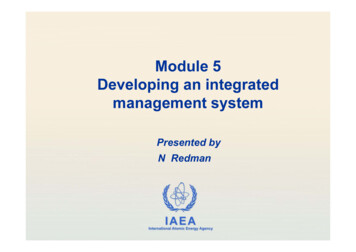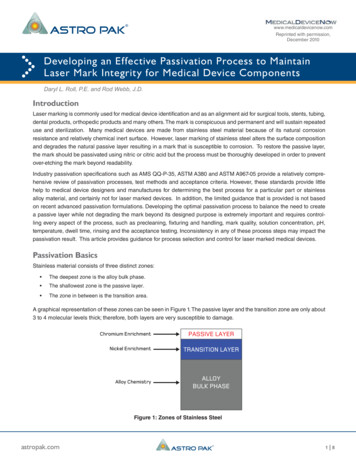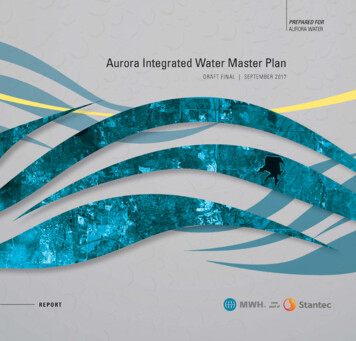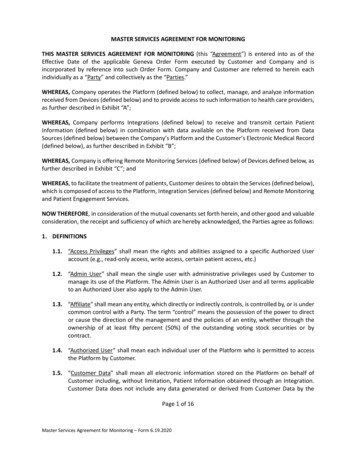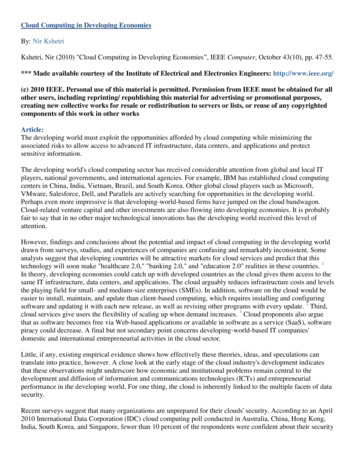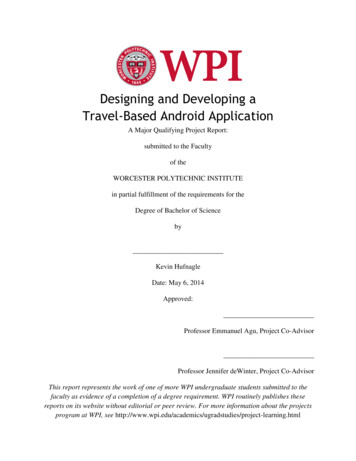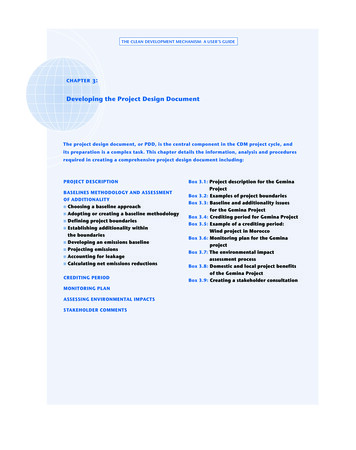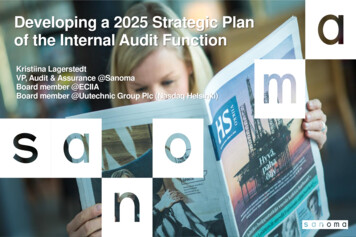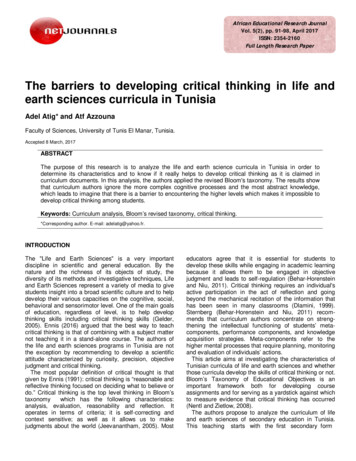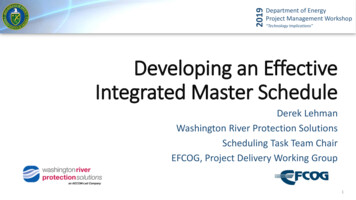
Transcription
2019Department of EnergyProject Management Workshop“Technology Implications”Developing an EffectiveIntegrated Master ScheduleDerek LehmanWashington River Protection SolutionsScheduling Task Team ChairEFCOG, Project Delivery Working Group1
Problem Statement“ in almost every EIR, PPR, EVMS review, etc., an inadequate IMSis highlighted as a major finding, or finding.”- Customer comment to our FY2018 Project Delivery Working Group WorkPlan2
EFCOG Challenge How do we turn this around?3
What is an IMS? IPMR DID – DOE Version October 2017, Section 3.7.1.1 The IMS shall include, at a minimum, discrete tasks/activities, consistentwith all authorized work, and relationships necessary for successfulcontract completion . . . The IMS is a single integrated network that alsocontains significant external interfaces, Government furnishedequipment/information/property and relationship dependencies for theentire contractual effort.4
What is an IMS? Planning and Scheduling Excellence Guide (Version 3.0) IMS provides the program team with a program execution roadmap ofmeaningful progress and realistic forecasts against a resource-loadedperformance measurement baseline. The primary purpose of any IMS is to help the Program Manager and theProgram Team optimize the overall execution strategy of a program,coordinate workflows, and assist in the decision making processes tomitigate risks and resolve challenges on a day-to-day basis.5
Build Compliant Integrated Master SchedulesIMS Building Blocks: Start with the NDIA EIA-748 Intent Guide Guideline 6 – Schedule with Network Logic “a) Schedule the authorized work in a manner which describes thesequence of work and identifies significant task interdependenciesrequired to meet the requirements of the program.” Time-phasing of authorized discrete work for use as a performancemeasurement baseline.6
Build Compliant Integrated Master SchedulesIMS Building Blocks: Understand and employ the applicable tenants of the: NDIA Planning & Scheduling Excellence Guide (PASEG)and GAO Schedule Assessment Guide Best Practices Align contractor schedule guidance to the body of knowledge7
Leverage Available Industry Guidance NDIA Planning & Scheduling Excellence Guide (PASEG) Generally Accepted Scheduling Principles (GASP)Leadership, Buy-In, CommitmentSchedule ArchitectureStandard Modeling TechniquesCost & Schedule Resource IntegrationExternal Schedule IntegrationHorizontal & Vertical TraceabilitySchedule MaintenanceSchedule AnalysisBusiness Rhythm & SubmittalTrainingProgram & Contract Phase Considerations8
Incorporate Industry Assessment Guidance GAO Schedule Assessment Guide Best Practices Capturing All EffortSequencing All ActivitiesAssigning Resources to All ActivitiesEstablishing the Duration of All ActivitiesVerifying That the Schedule Can Be Traced Horizontally and VerticallyConfirming That the Critical Path Is ValidEnsuring Reasonable Total FloatConducting a Schedule Risk AnalysisUpdating the Schedule Using Actual Progress and LogicMaintaining a Baseline Schedule9
Focus on Eliminating Recurring IMS “Findings”Recurring EIR, PPR, EVMS review findings as provided by PM-30and EFCOG:1.2.3.4.5.Lack of PlanningLack of Detail/Fidelity in the ScheduleLack of Baseline Schedule ManagementLack of Forecast Schedule ManagementLack of Process & Management Buy-in10
Focus on Eliminating Recurring IMS “Findings”1. Lack of Planning Utilize an Integrated Master Plan / Integrated Master Schedule (orlike) approach To the extent practical, ensure all known deliverables are includedduring the schedule development process Ensure risk mitigation activities are integrated into the schedule Resource allocation11
Focus on Eliminating Recurring IMS “Findings”1. Lack of Planning (continued) Overly optimistic Schedules should be aggressive yet achievable. Durations are based on “most likely” estimates, opposed to bestor worst case. Successful schedules include margin to account forrisks/uncertainty, based on the results of a Schedule RiskAssessment (SRA). Avoid building schedules with reduced durations or incompletelogic with the intent of meeting management or customerimposed schedule or budget targets.12
Focus on Eliminating Recurring IMS “Findings”2. Lack of Detail/Fidelity in the Schedule Not enough detail / excessive durations Too much detail, especially far-term effortSo . . .13
Focus on Eliminating Recurring IMS “Findings”2. Lack of Detail/Fidelity in the Schedule (continued) Utilization of Rolling Wave planning: Over time, more is knownabout the project. The schedule is continually monitored and detailplanned to reflect the increased knowledge. Increased schedule detail: Planning Package to Work Packageconversion. Updates to Schedule Risk Assessments: SRA should included anynew, revised or mitigated risks. Revised estimates: Estimates are updated as necessary in parallelwith revisions to schedule detail and SRA results.14
Focus on Eliminating Recurring IMS “Findings”2. Lack of Detail/Fidelity in the Schedule (continued) Missing logic or incorrect logic Redundant logic Excessive logic (merge bias) Out of Sequence Logic Lags and Constraints Avoid over-reliance on supplemental schedules15
Focus on Eliminating Recurring IMS “Findings”3. Lack of Baseline Schedule Management Not maintaining the baseline schedule invalidates the PMB andany association of performance measurement. A Baseline schedulewhich no longer accurately reflects the execution strategy fails toprovide management with a meaningful basis for performancemanagement Examples: Significantly behind (or ahead) of schedule, make vs.buy decisions, significant change (additions, elimination, revisions)to requirements.16
Focus on Eliminating Recurring IMS “Findings”3. Lack of Baseline Schedule Management (continued) Baselining to late dates in order to report favorable metrics. Lack of integration of subcontractor schedules into the baseline toreflect negotiated start and finish dates and hour/dollar spreads toalign with schedule of values.17
Focus on Eliminating Recurring IMS “Findings”4. Lack of Forecast Schedule Management Updates to the forecast schedule follow a consistent businessrhythm Consistent status dates Allows time for review18
Focus on Eliminating Recurring IMS “Findings”4. Lack of Forecast Schedule Management (continued) Not maintaining the forecast schedule with updated status and ETCtime-phasing: The forecast schedule includes accurate progress to date (actualstarts, finishes, and percent complete). All future durations and forecasted resource needs are updated asnecessary to reflect the most up to date information. Adjustments to logic are made to reflect work around strategies inthe forecast schedule.19
Focus on Eliminating Recurring IMS “Findings”5. Lack of Process & Management Buy-in Ensure CAM understanding on the differences between the Baselineand Forecast schedules and their roles and responsibilitiesthroughout the process. The WBS, Schedule and Cost Estimate align with each other. Integrate Cost Estimating and Schedule Risk into the scheduledevelopment process.20
Focus on Eliminating Recurring IMS “Findings”5. Lack of Process & Management Buy-in (continued) Utilize standardized processes: Data dictionary, reporting calendar,common durations/templates when applicable. Perform frequent analysis of schedule health and document results. Continually review processes and procedures against evolvingindustry guidance. Provide continued training on changes to process or to reinforceexisting requirements Leverage on results of schedule health analysis to ensurecompliance to processes and procedures21
Focus on Eliminating Recurring IMS “Findings”5. Lack of Process & Management Buy-in (continued) “A poorly constructed schedule is a program management problem,and not a planner/scheduler problem. A poorly constructedschedule is a result, not a cause. Find the root cause” (PASEG V3.0) Schedules which do not provide management value will be replacedby auxiliary tools which voids the IMS.22
Utilize Peer Reviews to Assess Compliance EFCOG Proposes utilization of the Project Delivery WorkingGroup Scheduling Task Team Task team would operate under the “Poneman” Project PeerReview Memorandum Coordinated with and by the EFCOG Scheduling Lead23
Utilize Peer Reviews to Assess Compliance Review team would be available to provide scheduleanalysis to assess the compliant condition of schedules insupport of and in advance of scheduled: EIR’s IPR’s IBR’s PPR’s EVMS Certifications and Surveillances Or other activities as requested by DOE or EFCOG contractors24
Utilize Peer Reviews to Assess Compliance25
Problem Statement“ in almost every EIR, PPR, EVMS review, etc., an inadequate IMSis highlighted as a major finding, or finding.”- Customer comment to our FY2018 Project Delivery Working Group WorkPlan26
Effective IMS Implementation Process Summary Leverage on Industry and internal guidance when building an IMS NDIA EIA-748 Intent Guide Guideline 6 – “Schedule with Network Logic” NDIA PASEG GAO Schedule Assessment Best Practices Align contractor IMS schedule implementing policy, procedures, guides,processes, tools, and training with the industry guidance (above).27
Effective IMS Implementation Process Summary Focus on Eliminating Recurring Findings Lack of Planning Lack of Detail/Fidelity in the Schedule Lack of Baseline Schedule Management Lack of Forecast Schedule Management Lack of Process & Management Buy-in28
Effective IMS Implementation Process Summary Assess Compliance Routinely assess schedule health metrics. Routinely assess implementation procedures, guides, processes andschedules to assure continued alignment. Consider an EFCOG Schedule Peer Review to validate compliance andguard against bias. Share peer review results with EFCOG members to provide lessonslearned, reinforcing self-governance.29
Effective IMS Implementation Process Summary Use the IMS An effective IMS is used in the decision making process. When the IMS is not used to make decisions, identify and address thecause. As the causes are addressed the IMS will begin to build credibility, thusincreasing its use as a management tool30
Discussion and Ideas!31
2019 Project Management Workshop “Technology Implications” 1 Developing an Effective Integrated Master Schedule Derek Lehman Washington River Protection Solutions. Scheduling Task Team Chai
